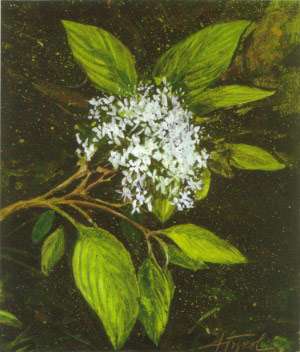
For holding soil in place along the upper banks of streams, it would be hard to improve upon red osier dogwood – though there are other dogwood species and many willows that also perform that function. Aboveground, the mass of red osier stems, although they are each less than an inch in diameter, collectively absorb energy from floodwaters, moderating the erosional power of a raging stream. If you test the toughness and flexibility of the stems by bending and trying to break them, you will quickly understand how red osier survives such torrents. The same characteristics make it suitable for baskets.
It is the underground fraction, however, that truly seems designed for the job of maintaining a streambank. Interwoven beneath the soil surface, a thick tangle of stolons (underground stems) connects the multiple stems to each other. At each node, a stolon produces a new shoot and a new mat of fibrous roots, and these new shoots then send out yet more stolons, creating a dense mat of plant material.
Native from Newfoundland to Alaska, and south to Virginia in the East and southern California in the West, red osier has the largest range of all the dogwoods. In addition to its natural occurrence, it has been planted to stabilize the banks of streams and rivers throughout its range. It does well when planted in any rich, moist soil and makes a nice border to the yard.
An essential feature of any plant used for rehabilitating scoured or otherwise degraded sites is that it is easy to grow, and red osier is highly obliging. Cuttings root reliably and, once planted, can be counted on for fast early growth as long as some moisture is available. Once red osier has become established, it will naturally spread vegetatively to form a thicket. In addition to spreading by stolons, new stems grow from the tips of older stems that droop to the ground.
Hardy to Zone 2, it withstands bitter cold once it has become acclimated. Its ability to tolerate extreme cold has attracted researchers, and in the laboratory, red osier has been found to survive after being subjected to -320ºF (-196ºC) – making me wonder if perhaps there should be an international treaty prohibiting such cruel experiments.
Red osier is quite common in the Northeast wherever the soil is moist or intermittently saturated: along streams and rivers, in wet roadside ditches, and as a fringe on the dry side of alders around the borders of wetlands. Its abundance is good news for many birds and mammals, mostly because of the edible fruits and twigs, but also as cover because it forms a barely penetrable thicket. Goldfinches prefer red osier for nesting, and their nests only become visible after the shrub has lost its leaves.
In winter, raggedly bitten off twig ends are likely to be the result of a visit by a white-tailed deer that stopped by to eat one of its favorite winter foods. Snowshoe hare leave a more cleanly cut end, and moose will reduce a thicket to a small hedge.
The white, fall fruits attract the largest number of consumers, including turkey, grouse, flicker, brown thrasher, and bluebird, for which it is a preferred food. Many other birds are occasional users, often waiting until hard times. Being low in sugar, the fruits are not popular with everyone, but this trait also means that the berries don’t rot. Because they usually stay on the shrub for many months, they are available when other foods have become scarce.
The small, cream-colored flowers are in flat-topped clusters. They are bisexual, but the male and female structures are programmed so that they don’t self pollinate. Instead, abundant nectar is used to recruit bees and other insects to do the cross-pollinating. In late May and June, the flowers are full of bees, along with some flies, beetles, and butterflies. The seeds are dispersed by the many animals that feed on the fruits.
The redness of the stem of red osier, caused by the presence of anthocyanins, the same pigments that cause reds in fall foliage, varies with the season and the amount of sunlight the stems are exposed to, typically brightening in the fall and becoming even brighter red as the days lengthen in spring. Year-round, there is enough red to make this shrub easy to identify. Fall color is variable but sometimes is a beautiful wine red.


Discussion *